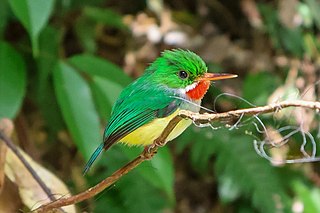
The Puerto Rican tody is a bird endemic to Puerto Rico. It is locally known in Spanish as "San Pedrito" and "medio peso".

The Puerto Rican woodpecker is the only woodpecker endemic to the archipelago of Puerto Rico and is one of the five species of the genus Melanerpes that occur in the Antilles. Furthermore, it is the only resident species of the family Picidae in Puerto Rico. The species is common on the main island of Puerto Rico and rare on the island of Vieques.

The Puerto Rican tanager is a small passerine bird endemic to the archipelago of Puerto Rico. It is the only member of the genus Nesospingus and has historically been placed in the tanager family, but recent studies indicate it as either belonging in its own family Nesospingidae or as being a member of Phaenicophilidae. Its closest relatives are likely the spindalises. The Puerto Rican tanager is known to locals as llorosa, which means 'cryer'.
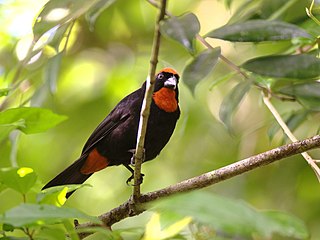
The Puerto Rican bullfinch is a small bullfinch tanager endemic to the archipelago of Puerto Rico. The species can be commonly found in heavy forests throughout Puerto Rico, except on the easternmost tip of the island. It consumes seeds, fruits, insects, and spiders. The nest is spherical, with an entrance on the side. Typically three light green eggs are laid.

Spindalis is a genus consisting of four non-migratory species of bird. It is the only genus in the family Spindalidae. The species are mostly endemic to the West Indies; exceptions include populations of western spindalises on Cozumel Island, off the Yucatán Peninsula's east coast, and in extreme southeastern Florida. The species were traditionally considered aberrant members of the tanager family Thraupidae. Taxonomic studies recover them as a sister group to the Puerto Rican tanager, and some group Spindalidae and Nesospingidae within the Phaenicophilidae.

The Hispaniolan spindalis is one of four species of bird in family Spindalidae. It is endemic to the Caribbean island of Hispaniola which is shared by Haiti and the Dominican Republic.
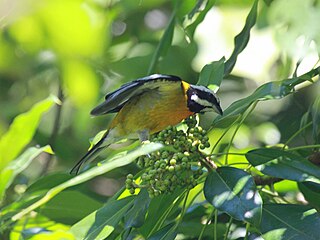
The Jamaican spindalis is one of four species of bird in family Spindalidae. It is endemic to Jamaica.

The western spindalis is a songbird species. It was formerly considered conspecific with the other three species of Spindalis, with the common name stripe-headed tanager.

Laguna Tortuguero Natural Reserve is a natural reservoir located between the municipalities of Vega Baja and Manatí in Puerto Rico.
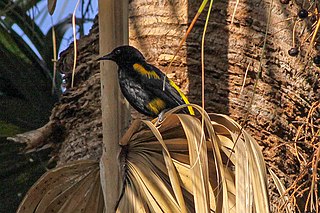
The Hispaniolan oriole is a species of bird in the family Icteridae. It is endemic to the Caribbean island of Hispaniola.

The Puerto Rican oriole is a species of bird in the family Icteridae, and genus Icterus or New World blackbirds. This species is a part of a subgroup of orioles that includes the North American orchard oriole, Icterus spurius, and the hooded oriole, Icterus cucullatus.

The Puerto Rican sharp-shinned hawk, falcón de sierra or gavilán pecho rufo in Spanish, is an endemic subspecies of the North American sharp-shinned hawk, occurring only in Puerto Rico. Discovered in 1912 and described as a distinct sub-species, it has been placed on the United States Fish and Wildlife Service list of endangered species because of its rapidly dwindling population in Puerto Rico. It can be found in the Toro Negro State Forest.

Cordia sulcata is known commonly as moral, white manjack, or mucilage manjack. It is a tree that can be found throughout the Caribbean islands from Cuba to Trinidad.

The Jamaican red-tailed hawk is the nominate subspecies of the red-tailed hawk, a bird of prey of North America. The subspecies B. j. jamaicensis occurs in the northern West Indies, including Jamaica, Hispaniola, Puerto Rico and the Lesser Antilles, but not the Bahamas or Cuba, where it is replaced by the Cuban red-tailed hawk. El Yunque National Forest, Puerto Rico, holds some of the highest known density of Jamaican red-tailed hawks. The bird is referred to as a guaraguao in the Dominican Republic and Puerto Rico.
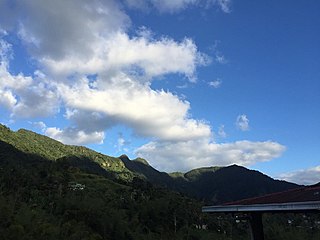
Los Tres Picachos State Forest is one of the 20 forests that make up the public forest system of Puerto Rico. The forest is located in the Central Mountain Range or Cordillera Central, along the Los Tres Picachos mountain ridge, one of the island's highest mountains, named after the distinctive three peaks of the highest mountain in the forest. The state forest is located in the municipalities of Jayuya and Ciales.

San Patricio State Forest, also known as the San Patricio Urban Forest is one of the 20 forests that make up the public forest system of Puerto Rico. This is a secondary or second-growth forest is located in the Gobernador Piñero district of San Juan, between the neighborhoods of Villa Borinquen, Caparra Heights and Borinquen Towers complex. The urban forest has entrances on Roosevelt Avenue and Ensenada Street. The forest extends to almost 70 acres and it is the smallest protected area in the Puerto Rico state forest system. One of the most distinctive features of the forest is the mogote on its northern edge which can be observed from many parts of San Juan and Guaynabo. The forest is part of the Northern Karst.

Nuevo Milenio State Forest is one of the 20 forests that make up the public forest system of Puerto Rico. The forest is located east of the University of Puerto Rico Botanical Garden in the Sabana Llana Sur district of San Juan, making it one of the two state forests located within the capital's municipal boundaries.

Guajataca State Forest is one of the 20 forests that make up the public forest system of Puerto Rico. The Guajataca Forest is located in the northwestern part of Puerto Rico, along the Northern Karst zone in the municipality of Isabela and municipality of Quebradillas, and is near Camuy and San Sebastián. The forest is renowned for its ecological diversity, the mogotes and karstic formations, and its numerous caves and canyons. It also has the largest trail system of any Puerto Rican state forest.




















